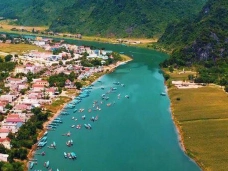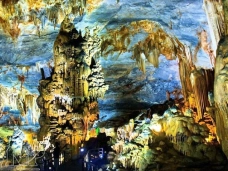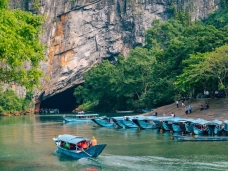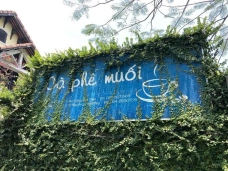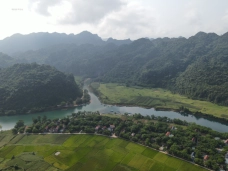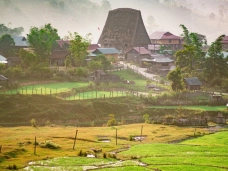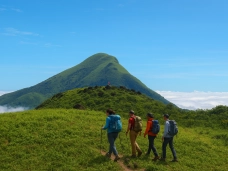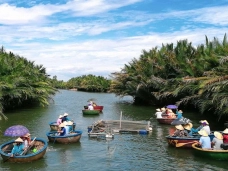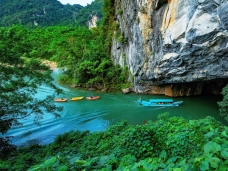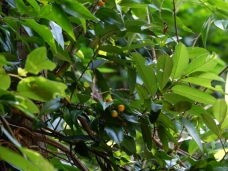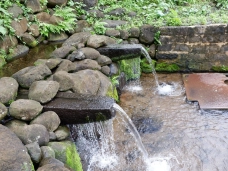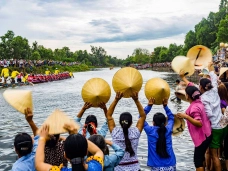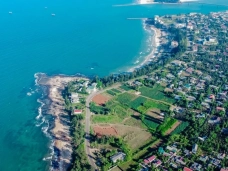Vinh Moc Tunnels – Sunlight in the Darkness
26-04-2025 16:00
Main contents
"We didn't dig tunnels to live forever underground—we dug them so we could live freely above ground, without the sound of bombs and bullets."
I heard these words while standing silently at the entrance of the Vinh Moc Tunnels on a windless, sunlit day. The red basalt soil still carries the rich scent of a time steeped in smoke and fire. The speaker was Uncle Thanh, a former logistics worker during the war. His words struck me deeply as I faced the dark tunnel mouth—a place that once housed an entire world, a dream of freedom amidst the chaos of war..

Revisiting Vinh Linh – A Land Between Two Frontiers
I arrived in Vinh Linh after a long journey along National Route 1, crossing the Hien Luong Bridge over the Ben Hai River, once the dividing line between North and South Vietnam. This trip was more than a tour; it was a journey back in time, to a place where every inch of land tells vivid stories of war and humanity.
Throughout the journey, memories of the past echoed in my mind. I recalled the film "17th Parallel, Days and Nights" by director Hai Ninh, where each frame is soaked in smoke and tears, recreating the heroic and harrowing days and nights of Vinh Linh's people along the demilitarized zone.
And somewhere in the wind rustling through the casuarina trees, I remembered the song "By the Hien Luong Shore" by the late musician Hoang Hiep—a poignant melody filled with the pain of separation:
"By the Hien Luong shore
This evening, I stand and look back..."
These lyrics seem to tether the soul, evoking the painful yet hopeful years of division—when every breeze over the Hien Luong Bridge carried promises of reunion.
"Here, bombs fell beyond count," Uncle Thanh recounted as if sharing a familiar story. "The Americans dropped over 560,000 tons of bombs on Vinh Linh—averaging seven tons per person. Every two minutes, there was a plane overhead; every ten minutes, the sound of naval artillery from offshore."
Sunlight in the Darkness
As I bowed to enter the tunnel, an eerie echo greeted me—like whispers from history. The narrow, dark passage pressed cool earth against my shoulders, and the musty scent permeated each breath. Beneath my feet lay the imprints of countless footsteps fleeing death, of embraces shared through nights of relentless bombing.
"There are three levels here," Uncle Thanh pointed out, his voice steady in the confined space. "Twelve meters, fifteen meters, and the deepest at twenty-three meters—the safest depth against penetrating bombs."
Each section of the tunnel tells a story: a small meeting room lit by flickering oil lamps where life-and-death decisions were made; a Hoang Cam stove still blackened with soot, where hurried meals fortified spirits; a cramped medical room barely fitting two people, where wounds were treated not just with medicine but with hope.
At the end of one branch, I paused for a long time before the maternity room—where life was nurtured amidst the devastation.
In the profound darkness, each person here was a sun—radiating light not from lamps or fire, but from an unyielding will and an undying desire to live. I thought of the people of Vinh Linh during those brutal times: each shovel digging deeper, each basket of earth carried away, each breath held underground—not merely to evade bombs, but to seek a glimmer of existence, of freedom.
Standing beside me, Uncle Thanh's voice caught in his throat:
"Seventeen children were born here. They were named Peace, Freedom, Life..."
Underground, amidst darkness and ruin, life never ceased.
On the contrary, it quietly ignited sparks of hope—silent, yet never subdued.

The Tunnels – A Symbol of Aspiration
Watching archival footage of the Vinh Moc Tunnels—grainy black-and-white images heavy with smoke and silent tears—and witnessing firsthand the scars of war etched into Vinh Linh's soil, I grasped the profound depth of pain and the immense strength of resilience. This indomitable land bears the remnants of tunnels flattened by American bombs: Don Due, Tan Ly, Xom Boc, Binh Minh...
In just four tunnel collapses, 126 lives were lost forever beneath the cold earth. This land absorbed not only blood but also the fervent dreams of life and freedom that burned for decades.
Uncle Thanh, his voice tinged with sorrow, recounted slowly:
"The day the Xom Boc tunnel collapsed, my brother was on guard inside... That afternoon, only a single sandal remained."
There were no tears, no farewells, no complete funerals. Only pain turned to stone, seeping into every grain of earth, echoing silently in people's hearts.
Yet, Vinh Moc did not fall.
For nearly 2,000 days and nights, the tunnels stood steadfast, sheltering over 300 people amidst the storm of bombs and bullets. And they didn't merely survive—they lived: holding weddings, giving birth, learning to read, healing the sick, together building a small, quiet world full of life, right beneath the dark earth.
Reflecting on this, my heart aches with an indescribable emotion. It's said that the engineer who designed the Vinh Moc Tunnels was a war veteran who had studied air-raid shelter construction in China. But this miracle wasn't born from dry blueprints—it came from the bare hands of Vinh Linh's people: hoes, shovels, baskets, sweat mingled with blood.
They didn't just dig to avoid bombs.
They dug deep into Mother Earth to sow an intense desire to live, defying all destruction, defying death lurking every moment.
Looking out at the calm East Sea in the distance—toward which the tunnel exits face—the sunlight hits my eyes, and I squint, seeing the sky turn bluer after hours spent in darkness. "We didn't dig tunnels to live forever underground," Uncle Thanh repeated. "We just wanted to live. And be free."
I nodded. The Vinh Moc Tunnels are more than a relic—they are an enduring declaration: that when pushed to the brink, humans can choose to dig deep—not to hide, but to await the day they can live again on the land of peace.

Epilogue
As the journey concluded and I headed home, my memories played like a slow-motion film, capturing indelible images: the sky-rending bombs, the roar of planes, the thunder of artillery along the Ben Hai River; devastated villages, mothers clutching children fleeing through smoke and fire; and above all—the intense desire to live, to reunite, to be whole between brothers and sisters, across both banks of Hien Luong.
I thought of my family. My father's and mother's relatives—like many Vietnamese families—once separated, suffered losses in the harsh context of a divided nation. That pain isn't a distant historical page—it's the blood flowing within me. I felt more than ever the silent sacrifices our ancestors endured so we could live in peace today.
This journey, more than an exploration, taught me about the miraculous strength of the Vietnamese people, especially the residents of Vinh Linh—who turned the earth into a homeland, darkness into light, bombs into an immortal song of resilience.
I suddenly recalled the famous question from Shakespeare's Hamlet: "To be or not to be?"
For the people of Vinh Linh, for the Vietnamese nation in those years, the answer was never hesitant. They chose "to be," chose to live—not just to exist, but to live proudly, steadfastly, with all the love for their homeland and an unyielding spirit.
There are lights that shine without lamps. There are people who, without weapons, create miracles. And there are journeys—that quietly, yet powerfully, mature our hearts.
Tuệ Minh
Comments
Comments (Total 1)
Tiến Phan
27-05-2025
Related Articles
13-12-2025
Giải mã tên gọi Phong Nha – Kẻ Bàng
26-11-2025
Khe Sanh – A Journey into Memory
05-11-2025
8 Unmissable Instagram Spots in Da Lat
28-10-2025





